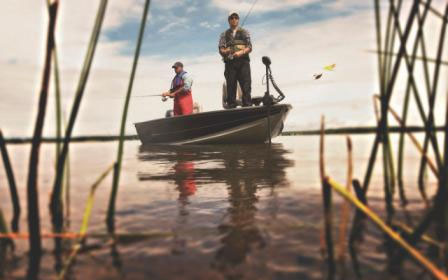Why Monitoring of the Great Lakes Coastal Wetlands is Important
Within the Great Lakes Basin, wetlands support many important ecological functions and provide numerous economic and cultural benefits. Monitoring of coastal wetlands helps the EPA and resource managers understand the status of these important ecosystems and the factors that influence their health.
On This Page:
Ecological Functions of Wetlands
Great Lakes coastal wetlands play an important role in maintaining the water quality of the Great Lakes. Wetlands have the potential to "capture" excess nutrients originating from upland habitats and other nonpoint sources by sequestering (storing) them in plant and animal tissues as well as in sediments. A healthy, intact wetland can store large amounts of nutrients (e.g., nitrogen, phosphorus) and some heavy metals (e.g., lead, zinc, cadmium, copper) for long periods of time and reduce the amount of nutrients and contaminants transported into the Great Lakes. Coastal wetlands also influence water quality by helping to maintain natural movement and settlement of sediments from tributaries.
Great Lakes coastal wetlands support biological diversity of native species by providing diverse habitats that are essential for the conservation of rare, threatened, and federally endangered species as well as common species.[1] More than 80 species of fish rely directly on coastal wetland habitat at some point in their life cycle and over 50 fish species are solely dependent on coastal wetlands for the entirety of their life cycle.[2] Many fish species, such as northern pike, yellow perch, walleye and bowfin, use coastal wetlands for spawning and nursery habitat. Other wildlife, including federally endangered or threatened species, such as the piping plover, Karner blue butterfly and Blanding's turtle, use Great Lakes coastal wetlands for resting, feeding and nesting habitat.
Economic and Cultural Benefits of Wetlands
The economic and cultural benefits of coastal wetlands reflect their contribution to recreational activities, commercial fishing, shoreline protection against storms and flooding, and traditional food supplies for Native American tribes.
Coastal wetlands provide recreational opportunities such as sport fishing (Figure 1), waterfowl hunting, trapping, kayaking, boating, bird watching and photography. These recreational activities account for more than $50 billion annually in economic activity within the Great Lakes region.[3] Great Lakes commercial and recreational fisheries, which have an annual revenue of $7 billion (U.S. only) and provide nearly 75,000 jobs, are supported in part by the many fish species that rely upon coastal wetlands.[4]
Coastal wetlands provide a buffer of protection for shorelines by absorbing the energy of waves that would otherwise cause excessive erosion and property damage during storms. Coastal wetlands also can reduce the severity of flooding by absorbing large amounts of water and releasing it slowly following heavy rain.
Tribes have been harvesting wild rice from Great Lakes coastal wetlands for centuries, which is a historical and contemporary cultural practice (Figure 2). The wild rice provided by coastal wetlands is an important source of food and income for many tribal communities.

Photo credit: Tip of the Mitt Watershed Council

Photo credit: Tim Tynan
Coastal Wetland Loss
Coastal wetland areas once spanned over one million acres in the Great Lakes, but today only about half, or 532,938 acres, remain due to both historic and contemporary wetland losses.[1] Coastal wetlands are unfortunately experiencing continued losses in some parts of the basin due to human development, fragmentation, drainage and, to some extent, changing water levels (Figure 3). Stressors such as invasive species and point and nonpoint pollution may cause further degradation and loss.[5] The Coastal Wetland Monitoring Program (CWMP) provides valuable information on the status of coastal wetlands and key stressors they face. This information is used by resource managers to make informed restoration, enhancement and protection decisions.

References
[1] Brazner, J., Sierszen, M., Keough, J., Tanner, D.K. 2000. Assessing the ecological importance of coastal wetlands in a large lake context. Internationale Vereinigung für theoretische und angewandte Limnologie: Verhandlungen, 27. 1950-1961.
[2] Jude, D., Pappas, J. 1992. Fish utilization of Great Lakes coastal wetlands. Journal of Great Lakes Research. 18. 651-672.
[3] Austin, J., Anderson, S., Courant, P., Litan, R. 2007. America's North Coast: A Benefit–Cost Analysis of a Program to Protect and Restore the Great Lakes. Brookings Institute. Washington DC.
[4] American Sportfishing Association. 2013. Today's angler: A statistical profile of anglers, their targeted species and expenditures. Alexandria, VA.
Back to: About the Great Lakes Coastal Wetland Monitoring Program
